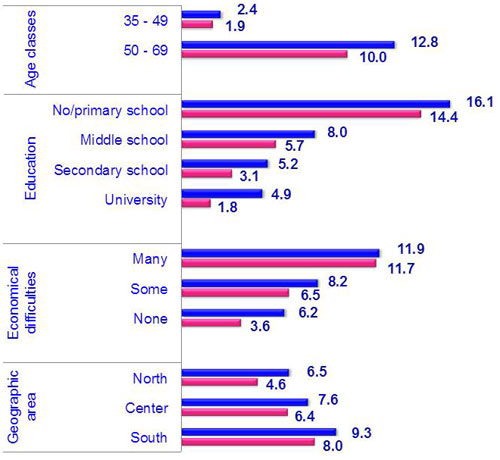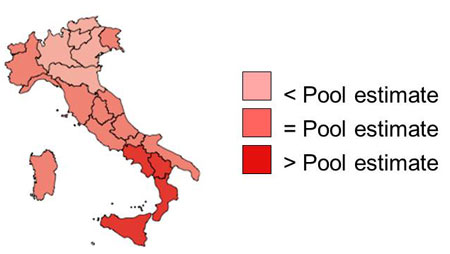Socioeconomic inequalities in the prevalence of diabetes in Italy
Data presented derives from the Italian Behavioural Risk Factor Surveillance System (PASSI).
The PASSI system is a cross-sectional health survey that was begun in 2007 to provide information on the health status of Italian adult population, through the systematic and continuous collection of data on lifestyles, chronic diseases, socio-demographic variables and adhesion to preventive programs. 93% of Italian Local Health Units (LHU), covering about 85% of Italy's 18-69-year-old population, participates in the surveillance. LHU residents (18-69 years) are randomly selected, and trained LHU personnel administer telephone interview using standardized questionnaire. A total of 94,996 persons were interviewed in the period 2007-2009. All statistical analyses were conducted weighting for the whole LHU population. Prevalence Rate Ratios (PRR) were estimated through a multivariate Poisson model.
Among the population aged 35-69 years, 6,9% reported to have diabetes (men: 7,7%; women: 6,2%). The prevalence increases with worsening of the socioeconomic conditions: for both men and women the prevalence was higher in people with lower education (men: 16,1%; women: 14,4%), and with economical difficulties (men: 11,9%; women: 11,7%).

In the period 2007-2009, the annual diabetes prevalence (population aged 35-69 years) displays significant geographical variations: 6,5% for men in the North, and 9,3 in the South; 4,6% for women in the North and 8,0% in the South.

The multivariate model confirmed a significant association of diabetes with age, gender, education, geographical area and economic difficulties. The PRR for a woman with low education (no education/primary school) vs. high education (secondary school/university) was 1,9 (CI 95% 1,6-2,3), and PRR for many difficulties vs. none was 2,1 (CI 95% 1,8-2,6). The PRR for men with low education vs. high education was 1,5 (CI 95% 1,3-1,7), and PRR for many difficulties vs. none was 1,5 (CI 95% 1,2-1,8).

 Integrazione, gestione e assistenza
Integrazione, gestione e assistenza